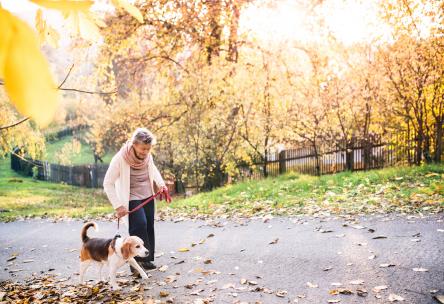The coming technology to help keep you from falling

It’s a tough but true fact: Serious falls are the leading cause of injury-related deaths in older Americans.
The good news: There’s new technology that can help prevent those often life-altering falls—and many more options are on the way.
“As technology costs fall, the ability to create new kinds of enhancements that help older people overcome deficits is the most exciting thing happening in the field now,” says Brad Manor, Ph.D., associate scientist at the Harvard-affiliated Hinda and Arthur Marcus Institute for Aging Research.
Manor knows that the sheer terror of taking a tumble creates its own problems—inhibiting movement and confining some people to their homes—which is why these products will be so crucial as they become more prevalent in the coming years. A few are already available, some are nearing introduction, and countless others are being perfected. Here’s a sneak peek:
Smart Devices
Sensor technology is creating devices that not only assist seniors but also provide medical professionals with data they can use to make life safer. For instance:
Computerized Canes
Tech tool Intellicane, pioneered by a Vanderbilt University team, will track the user’s movements, calculate fall risk, and dispatch data to caregivers.
The Next Generation of Walkers
Several smart walkers quantify balance problems, but one device goes further. A prototype brake-equipped walker can stop an imminent collision by applying its own brakes. The frame gathers input from encoders, a laser finder, and an ultrasound to scan for—and avoid—dangerous obstacles.
Safer Rooms
Touch-sensitive bedrails, chair pads, floor pads, and rugs can track fall risk and summon help, while the automated Luna Lights system anticipates and illuminates the path of the sometimes-dangerous nighttime bathroom trip. Once you’re in the bathroom, a smart scale can check balance, share data with a coaching application, and, oh yeah, determine weight.
Wearables
Super-tiny sensors are also showing up in clothing that helps keep seniors safe. The research firm Tractica predicts that approximately 27 million units of sensor-enabled clothing will ship annually by 2022. Some highlights to look for:
Shoes That Protect
Path Feel shoe insoles were named the Most Promising Idea in a 2017 AARP fall-prevention competition. The insoles' “vibrotactile” sensors deliver real-time vibration to the soles of the feet to improve walking patterns and prevent falls.
The new B-Shoe, currently seeking funding, takes the concept a step further—or, rather, backward. The shoes’ automatic braking system initiates a small step back when the wearer is dangerously wobbly. By stopping forward movement, the brake can, ideally, prevent a tumble.
Safety Belts
If the worst does happen, the Tango belt deploys an airbag to cushion the hips, where debilitating injuries often occur. In the near future, the belt may also measure postural sway, gait speed, and stride-time variability.
Home Monitoring
A sensor-based home monitoring system from CarePredict uses data from multiple locations to “learn” a user’s living patterns and alert contacts when things seem precarious. Tracking everything from unsteadiness to signs of infection, dehydration, hunger, or disorientation, it can notice life-threatening symptoms before they become obvious to others.
The Walabot HOME sensor confines its observation to a single location, but the iPad-sized, wall-mounted sensor can see and evaluate falls, even in pitch darkness or in steamy settings.
“This kind of technology is amazing because it doesn’t use video or wearables, so there is no privacy problem, but it can tell when a person changes position. And because it can also detect breathing, it won’t react when an inanimate object falls,” says Manor.
In institutions, patient-observer technology helps caregivers supervise many at-risk patients simultaneously. When the neuroscience unit at Mission Hospital in Asheville, North Carolina, piloted a system of intelligent monitors, fall-related injuries dropped by 40 percent.
Keeping Your Balance
Remaining upright and steady requires many factors, most of which can be measured and some of which can be predictive of falls.
The iStoppFalls prototype aims to assess mobility in daily life, then “prescribe” exercise through a video game system. It not only scans for potential weakness but also may help sharpen observational skills essential to good balance.
Detailed information about how well you walk and turn may one day become part of any standard medical workup. “These measurements will be as essential to a routine physical as a nurse measuring height and weight is today,” says Fay Horak, Ph.D., P.T., professor of neurology at Oregon Health & Science University.
After the Fall
Even with all of these innovations, the fall-detection industry’s most popular technology remains personal emergency response systems (PERS), of “I’ve fallen and I can’t get up” fame. These provide after-the-fact detection and reporting of falls. Less obtrusive and more sophisticated than earlier versions, current PERS chips hide in smartwatches, cell phone applications, hearing aids, and wearables.
But David Reuben, M.D., a UCLA physician who is one of the leads on a project to reduce falls in the elderly, says that they “have not been the panacea people were hoping for,” pointing out that they may provide too much information about minor disturbances or may provide important information only when it is too late to intervene.
Still, the ability to summon quick help can be life-saving. After a fall, the dangers posed by possible blood loss, dehydration, and additional complications increase over time.
Help Yourself
Regardless of the technology to come, it pays to follow good habits to avoid falls.
“Things like ensuring an older adult has clear pathways for walking, adequate lighting, good footwear, and appropriate assistive devices can minimize the chance they’ll lose their balance,” says William Campbell, Ph.D., a senior physical therapist for the Visiting Nurse Service of New York. Other experts have noted the importance of exercise, especially balance-focused regimens, including yoga.
“There’ll come a day when everyone will start working on balance training in middle age,” says Horak. “These are skills that everyone can learn and everyone can improve.”